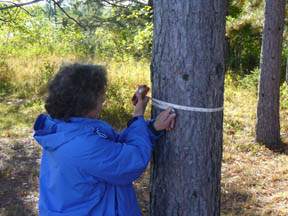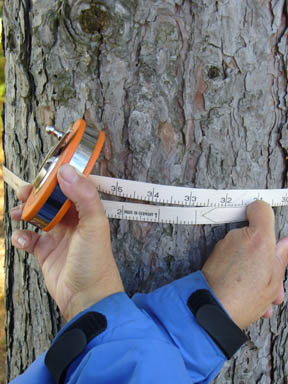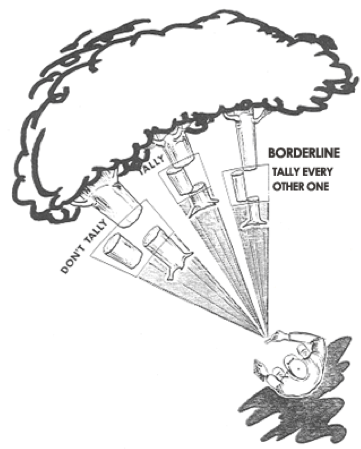Because trees are large and ecologically very central to forest ecosystems, in addition to species composition, diversity and percent cover, an estimate of the basal area and density of trees in a forest can be important.

To measure the dbh of a tree, wrap the DBH tape around the trunk at “breast height” which is 1.4meters from the ground.
When measuring DBH, pull the tape tight around the tree so the ends overlap and then read the measurement to the nearest 10th of a centimeter. In this example, the dbh of the tree being measured is 32.8cm
Density is simply the number of trees per unit area and is generally reported as the number of trees per hectare (1 hectare = 2.47 acres). There are 10,000 m² per hectare (abbreviated as “ha”), so once you determine the mean (average) number of trees per plot you can easily convert it to this unit. For example, a 10m x 10m plot = 100m². If you had an mean of 18 trees per plot, then the density would be 18 x 100 = 1800 trees/hectare.
Basal Area is the cross-sectional area of trees stem (trunk) at breast height. For individual trees, basal area is expressed as in square meters (i.e. 0.25m²). When estimating the average basal area of a forest stand it is generally reported as m² per hectare (i.e. 35m2/hectare). The basal area of a forest can be measured directly using a dbh tape or estimated by using a wedge prism.
A dbh tape is a specially calibrated tape that reads the diameter of the tree directly. The tape has a normal ruler on one side and the dbh scale on the other. Be sure to use a dbh tape calibrated for diameter in centimeters unless you want to convert from English to metric units.
Also, be sure to use the correct side of the dbh tape. Wrap the tape around the tree at a dbh (~4 ft above the average ground surface), holding the tape tight against the bark and record the dbh as read from the dbh side of the tape (usually marked with a slash through a circle at the very tip of the tape). Recording the dbh of trees is most easily done by two people working together, where one person measures and one records.

Once you have the diameter measurement of the tree, you can calculate its basal area using the formula for the area of a circle. The area of a circle = π x radius² , where pi (π) is equal to 3.14 and the radius is half the diameter.
So, if the diameter of your tree is 24cm, the radius is 12cm and the basal area would be:
Basal Area = 3.14 x (12cm x 12cm) = 452.2 cm²
To convert the basal area to square meters, either
- convert the original measurement to meters. In our example, 12 cm = 0.12 m. So, Basal Area = 3.14 x (0.12cm x 0.12cm) = 0.045 m²
- convert the final value from cm² to m² by multiplying it by 0.0001. In our example, basla area = 452.2 cm² x 0.0001 = 0.045 m²
A wedge prism is a forester’s tool for quickly determining basal area. The prism is cut in a particular way that shifts the position of the image of the tree trunk when you look at the tree through the prism. If the edge of the shifted image of the tree in the prism overlaps with the edge of the tree above the prism, then the tree is tallied. If the edges of the tree trunk don’t overlap the image in the prism, the tree is not tallied. If the edged exactly meet, the tree is recorded as “borderline” and every other one borderline tree is included in the tally (see Figure 2 below).

The wedge prism survey is often done in conjunction with surveys done in a plot. In these cases, to estimate the basal area of the plot, you stand near the center the plot, holding the prism at the exact center. View trees at dbh height (diameter at breast height = 1.4 m above the ground). Start tallying trees and move in a full circle until all potential trees have been examined. To ensure an accurate tally of trees to include, be sure the prism stays over the center of the plot when you view trees and then you rotate around it as you go.
Once you have tallied the trees at your sample location, you multiply the tally by the basal area factor (BAF) of your particular prism to get the estimated basal area for that sample location. So, if you tallied 12 trees and your prism had a BAF of 10 (in English units), the basal area of that location would be 120 square feet/acre. In eastern hardwood forests, most people us a wedge prism calibrated in such a way that each tree tallied is equal to 10 square feet of basal area per acre, (BAF = 10). There are other BAF values (10, 15, 20, etc.) and you can get them in either English or metric units, so just be aware of what the BAF and units are for the prism you are using. No matter which prism you use, the process is the same, tally the trees and multiply the tally by the BAF of your prism to get the basal area, voila! Quick and easy!
If you use a prism calibrated in English units (ft²/acre), be sure to convert it to metric (m²/hectare).